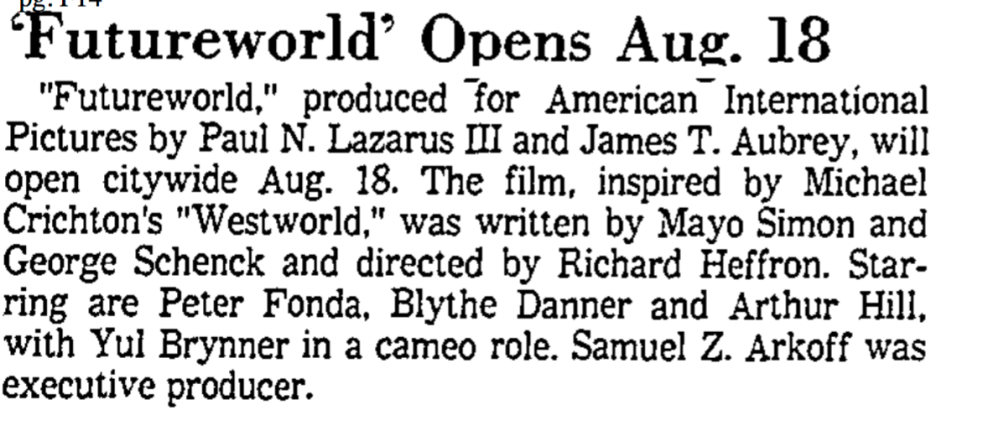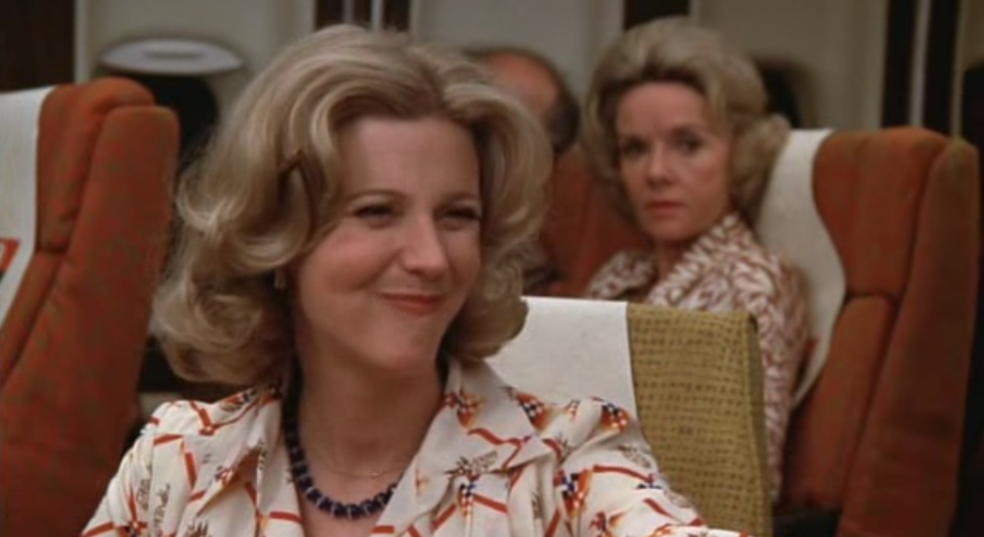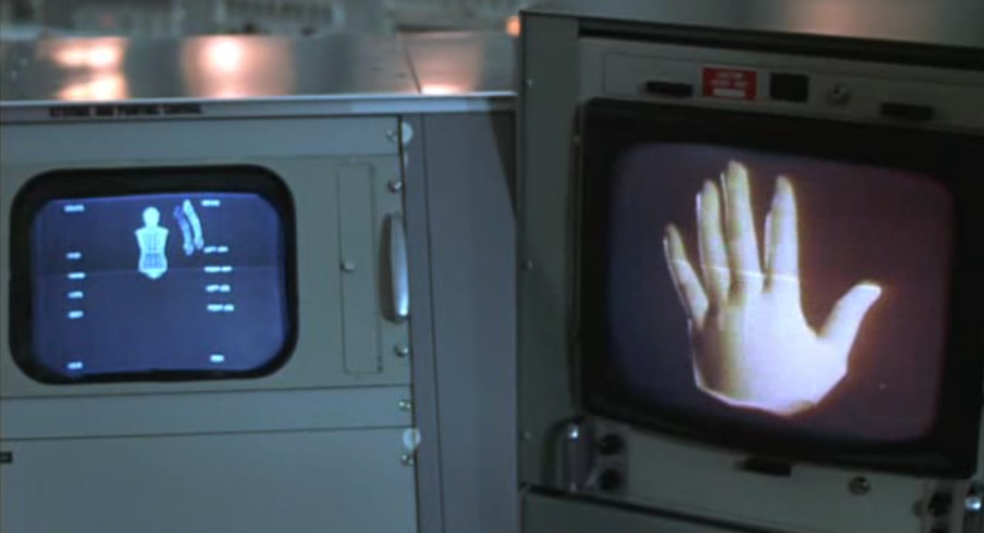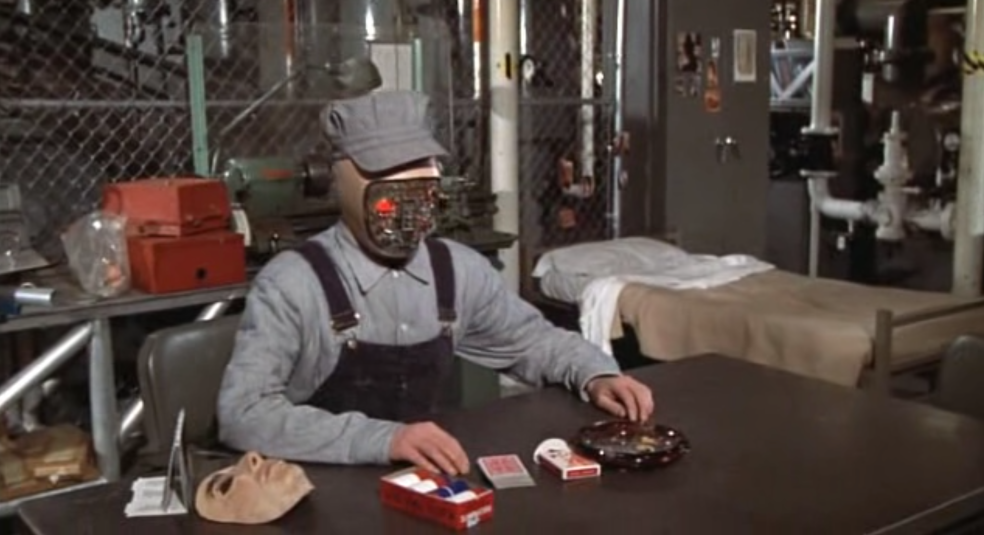Futureworld
Directed by Richard Heffron. Distributed by American International Picutures (AIP). 106 minutes.



- A sequel to Westworld (1974), even though producers called it an “extension” (which really doesn’t make sense), Futureworld started its life at MGM in 1974 while its predecessor was still in theaters. It’s all part of the weird story of James T. Aubrey, one of the great and bizarre producers/executives in Hollywood history…
- Aubrey, the head of CBS following the quiz show scandals in the 1950s, put shows like Gilligan’s Island and The Beverley Hillbillies on the air and dominated the ratings, and had an ego to match. He was fired in 1965 for “improprieties” –he had a reputation as a party boy all over the world and was known to squire young actress around town late into the night –and later became the basis of Jaqueline Susann’s novel The Love Machine in 1969, and the subsequent film, which was a lurid portrait of a TV executive.
- He then got hired by Kirk Kerokorian to salvage MGM in 1969 — which he did, to great effect, even though it meant firing hundreds and selling off MGM’s cameras, props, and backlots to tremendous infamy. He also alienated directors, edited films arbitrarily and without creative justification, and generally made enemies.
- He was responsible for getting Westworld lined up, which became a smash. Aubrey resigned in 1973, declaring his job done, before the movie was released, and went back to being an independent producer. I haven’t even talked about his connections to Howard Hughes!
- MGM ultimately decided to drop Futureworld and focus on Logan’s Run instead; Aubrey then took the project to American International Pictures (AIP), where Samuel Arkoff must have been delighted.
- Production took place in Houston, mostly in actual NASA facilities — which were underused at the time due to budget cuts. The producers were pretty proud of that, and talked about it incessantly in the publicity. A “three billion dollar set,” they liked to say.
- The film itself has a simple, sequel plot: the Dalos resort is back, fixed now, and the corporate bigwigs have invited two reporters (Peter Fonda and Blythe Danner) to check it out. But — gasp! — it turns out the computers have taken over, started replacing people with robots, and now they want the whole world. The reporters must escape before their replacements kill them. The end.
- Danner, Gwyneth Paltrow’s mother, certainly mugs her way through this performance just like she always did. It’s hard to say who’s more insufferable, Fonda, a low-rent Warren Beatty, or Danner. The strange sex scene they eventually share should have a sad trombone noise accompanying it. Here’s a typical Danner expression from the film:

- Speaking of reporters… I love the opening, which starts in the printing shop and then moves to the news floor (presumably the Houston Chronicle). Such a picture of an obsolete technology!
- There are shades here of technopanic (The Forbin Project) and journalism (All the President’s Men) and corporate thrillers (Three Days of the Condor) and even hints of government conspiracy (Capricorn One). It’s a hodgepodge, for sure, but mostly just making entertainment out of general unease about “the future.”
- Reasons to watch this film: 1 – the sets. They are bizarre, to be sure, and oddly feel like time capsules. The film was shot at the Houston Airport, a concert hall downtown, and NASA, and, frankly, it feels like it — these don’t feel like sets or actual locations, they feel (strangely, and hard to describe, I admit) like a film crew took over these places for the weekend.
- Boy oh boy did the producers love this shot of the “giant door opening” that used an actual Giant Door somewhere in the NASA center. They lingered on it forever in the final cut — it’s opening! — and then bragged about it in the marketing buildup. No doubt Michael Bay learned something there.

- 2 – the interesting visual effects – particularly the robots, which go a bit further than the last film, but also this very bizarre living, but miniature, chess set sequence.
- 2A – beyond the robots, I mean the strange visuals that Heffron created for the film. It’s interesting to me that he never really directed many movies again, and certainly no blockbusters. That includes the dream sequence with Yul Brynner, who gets prominent billing here for reprising his role as the “gunslinger” in one very short segment that’s got some light bondage overtones in its eroticism. It’s more of Heffron’s bizarre visuals, strangely hypnotic and definitely interesting. He definitely has a creative visision here that pushes the boundaries of what audiences were probably used to; sadly, he buries it in a formulaic and often boring movie.
- 3 – Don’t forget the first-ever use of CGI, which comes on a television monitor. The story there is that producers saw a student film by Ed Catmull created in 1972. Catmull made a CGI model of his hand, and then some facial stuff, too — all of which the producers bought up and put in this scene. Catmull ended up doing okay, too. He was one of the founders of Pixar. You can watch his original student film here.

- 3A – The culmination of all this is the actual creation of Fonda’s double, which includes more early CG stuff, then ending with a slow zoom out of Fonda’s eye and over his body — the same footage that opens the film. It’s creepy stuff.
- 4 – John Ryan, who is always amazing.

- 5 – Clark, the sad robot befriended by Harry, a workman in the bowels of the resort. When Harry finally has to flee and leave Chuck behind, well, it’s both funny and sad. They really are friends. Harry promises to come back for him… is that the unmade third in the series??

- Overall, the film doesn’t really work, since it never really knows what it is or where it’s going, ends abruptly, and doesn’t seem to invest much in developing a story. Odd subplots trail off and go nowhere, and the attempts at eroticism (such a part of the original) are pretty tepid and pointless here.
- Do love this final image, though — which apparently was re-shot for the television release to be Fonda thumbing his nose or something.

- AIP’s marketing campaign included lots and lots of theater promotions — including these antics by a Dallas theater to have the staff where homemade Clark masks. Amazing.
- The actor who portrayed Clark actually made dozens of live appearances — in characer! — at theaters around the country and on local television shows.
- There were also fashion shows, beauty pageants, banner flyovers, and all kinds of crazy events — like this one in New York, which is kind of nuts:

- Futureworld is mostly a dusty curiosity now, increasingly forgotten. I dig the creepiness of robots taking over — and we can’t even tell who is a robot! — but that story was told better in Invasion of the Body Snatchers.
- Even more forgotten is the five-episode Beyond Westworld television show that aired in 1980 on CBS. Of course, HBO is bringing back a very high profile Westworld show soon by Jonathan Nolan… Delos lives on, even if Futureworld does not. Maybe that’s for the best.
It was released forty years ago today.
























